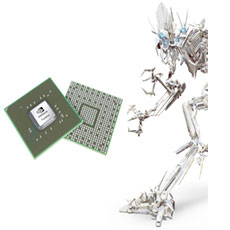Installing the Processor and Heat Sink.

Installing the processor and heat sink! Next is the processor. Before you install the processor you need to have some heat sink compound or grease that goes between the processor and the heat sink. Check the processor and heat sink, there may be a small plastic tube of heat sink compound or conducting-gel, if not you can buy some at your local electronics store. If the heat sink is already attached to the processor do not remove it, you will not need the heat sink compound. Look at the socket on the motherboard, there is a lever on the side, lifting this lever will move the locking mechanism to the open position. The socket is made so the processor will only fit one way. There are markings on the processor and the socket to indicate the #1 pin orientation. Some processors have a little triangle, some have a small dot, it may be black paint or an indentation in the metal cover. The socket will have a place where there are no pin holes in one corner. It may have a painted black dot also. Carefully lower the processor into the socket, if it does not drop into the pin holes on the first try you can try moving it around very gently the pins on the processor are very thin and coated with gold, they are not very strong individually and will bend or break easily. If it still doesn’t drop into the holes take it back out and check the #1 pin orientation.
If you have it orientated correctly and it will not drop in check the lever on the socket, close it and open it, the socket may not be completely unlocked. If it still will not drop in without force, look at the pins on the processor, you may have to use a magnifying glass to see the pins. See if any or bent. If you have a bent pin you can very gently straighten it with a pair of needle nose pliers or retractable ball point pen with the cartridge retracted. Once the processor has dropped into the socket, move the lever downward, some sockets will “click” when they lock, press the lever into the locking tabs. The processor should come with a heat sink and fan check the installation guide for the heat sink and fan on how to install them, apply the heat sink compound, then the heat sink and fan. Connect the fan cable to the motherboard connector. For cooling, we now install any extra fans we purchased! Prior to installing your cards a couple of considerations. For maximum cooling you should leave as much space as possible between cards, one slot or more this is especially important for the newer video cards with the newer MDAC which is a processor. Some will have a small fan with a heat sink to help keep the MDAC cool. Because they run at a higher frequency than the older video cards. This is also true for the newer sound cards. Keeping open space around these cards increases the cooling from the air circulating in the computer case. Speaking of cases, some of the case slots are not completely punched out, you may have to pry them one direction and then work them back and forth to break the metal that didn’t get completely cut during manufacturing. Be careful with these cases because the manufacture did not clean up the edges and they are razor sharp.
A small file to round off the edges would be a good idea, you never know when you may have to put your hand inside the case. If you do round off the edges use a vacuum cleaner to get the metal filings out before you power the system up!. When you install your cards you need to seat them, I always put the slot cover into the slot then slide the card down until it is setting in the slot, be careful that you don’t push the card into the slot at an angle you could damage the card, the slot retainer, or both. Install your add on cards, video, etc… Now we install any extra fans we purchased. The fans come in two types, those controlled by the motherboard and those connected to the power supply, install your extra fans. Most motherboards come with an instruction manual that will give the motherboard layout, the connections will be noted on the ‘map’ or drawing of the motherboard. Some motherboards have labels such as ‘Fan 1′, ‘Fan 2′, etc. Before we power up we need to check our work, check all the cable connections, drives, power, case connections, all secure? Last check, nothing in the fans? No extra screws or hard ware? No tools inside the case? Put the cover on the case, this will preclude you from touching anything while the system is powered up!
But first check the installation guide for the motherboard, you need to know the key sequence to get to the bios screen to set the time and date, drive types for the hard drive and cd/dvd. There are other settings you can make in the bios also. Those take some extra research and study before changing them! Connect up your keyboard, mouse, and video, turn on the monitor! Power up! See the bios listing, CPU Speed, and memory count? Press the key sequence to get to the bios, set your drives, time and date, any other parameters that you feel comfortable setting, let the system boot. Did the light on the floppy if installed and cd/dvd drives light up? If you have a new drive that is not formatted and has an OS installed you should get a non system disk error. All good? If you don’t have any problems you are ready to install the OS and play. If you don’t get a bios logo screen then something is not seated properly or has gone to ground. Disconnect the power cord! Then troubleshoot your installation. Miamicomputerrepairsite.com is one of the best repair shop in miami, Fl.
 Steven, L.
Steven, L.










